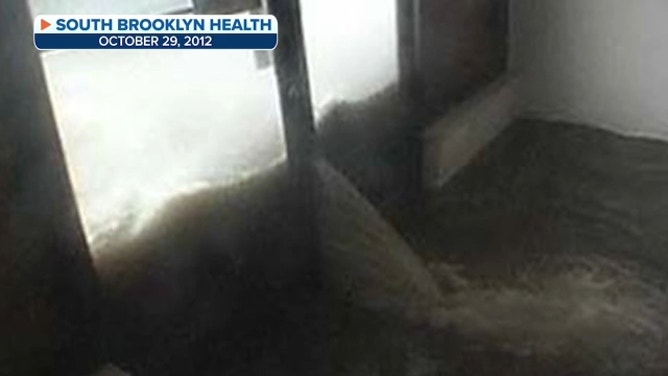Hurricane-resistant hospital built in NYC after Superstorm Sandy floods ER
Recently renamed the Ruth Bader Ginsburg Hospital, the former Coney Island Hospital in south Brooklyn saw its emergency room flood on Oct. 29, 2012.
New hurricane resistant hospital in New York replaces facility destroyed by Superstorm Sandy
Superstorm Sandy flooded the emergency room at the former Coney Island Hospital in South Brooklyn. 11 years later, FOX Weather's Amy Freeze takes you to the new Ruth Bader Ginsburg Hospital, a $1B hospital funded by a FEMA grant, built to be hurricane resistant.
NEW YORK – South Brooklyn Health unveiled a new hurricane-resistant, climate-proof facility nearly 11 years after flooding from Superstorm Sandy devastated the hospital.
Called the Ruth Bader Ginsburg Hospital, in honor of the late Supreme Court Justice who was born in Brooklyn, the facility opened for care earlier this month, funded by a nearly $1 billion-dollar FEMA grant that also financed other renovations to the South Brooklyn Health campus.
Previously known as the Coney Island Hospital, the hospital is located a few blocks from the Atlantic Ocean, and it saw its emergency room flooded on Oct. 29, 2012.
The night Superstorm Sandy flooded the hospital

Floodwaters at the door during Superstorm Sandy on October 29, 2012.
(South Brooklyn Health / FOX Weather)
"We thought we were safe," said Dr. Terrance Brady, who was on duty the night Superstorm Sandy flooded the emergency room. "Then all of a sudden, over a period of minutes, the ocean came all the way up Ocean Parkway into our front door."
According to Brady, the water began to pour into the emergency room, which was located in the basement of the hospital. He noted that it took about 30 minutes to fill the hospital basement with 15 million gallons of seawater.
Nearly two dozen patients were evacuated from the flooded emergency room, with staff pushing gurneys through 6 inches of seawater while trying to move them to the second floor. As they made their way to the elevators, however, they were paralyzed by darkness as the generators shut down.

Pushing a patient through the dark, flooded halls of the the hospital during Hurricane Sandy. October 29, 2012.
(South Brooklyn Health / FOX Weather)
"It was pitch black," Brady said. "You couldn't see your hand in front of your face as you got off the elevators with the last patients," Brady said.
WHY THE 2023 SUPERSTORM WAS SO DESTRUCTIVE IN THE NORTHEAST
Everyone survived that night despite the enormous challenges faced by both staff and patients.
Rebuilding the hospital to be hurricane-resistant

The new Ruth Bader Ginsburg Hospital.
(John Rae for NYC Health + Hospitals / FOX Weather)
Nearly 11 years after the terrible storm, the hospital announced it was open for care under the new name of Ruth Bader Ginsburg Hospital.
Funded by money from FEMA, the new hospital boasts features such as a storm-resilient design and a flood-proof emergency department, according to NYC Health + Hospitals.
TOP 5 COSTLIEST HURRICANES IN US HISTORY

Medical professionals and patients at the new hospital.
(John Rae for NYC Health + Hospitals / FOX Weather)
The emergency department has been moved to the second floor, which decreases its chances of experiencing flooding. Plus, ambulances are able to reach the emergency department by way of an elevated concrete ramp, which is heated and allows it to remain clear of ice and snow in the winter.
Another feature that makes the hospital more storm-resilient is a glass curtain wall.
"If we have high winds and something comes flying at our building, we can withstand," said Svetlana Lipyanskaya, CEO of NYC Health + Hospitals/South Brooklyn Health.
Fighting floods from future storms
New hospital in Brooklyn built to withstand future storms like Sandy
John Flanagan, Senior Associate and Technical Design Director at NBBJ, talks about what went into the design and building of the new Ruth Bader Ginsburg Hospital in Brooklyn, NY, to help it withstand future storms.
The FEMA grant was also put toward upgrades around campus, such as a four-foot concrete wall that surrounds the facility and can withstand a 500-year storm.
According to John Flanagan, technical design director with the architecture firm NBBJ and one of the designers of the new hospital, around the perimeter wall is an additional level of protection to about 12 feet above the floor level.
Flood-resilient power, heating, cooling and water systems have also been added and are now housed on the fifth floor. Multiple layers of redundancy, such as two generators and backup chillers, have also been added.
"We're really planning this building to serve this community for literally 100 years and beyond," Flanagan said.
The new Ruth Bader Ginsburg Hospital opened its doors on May 7.

